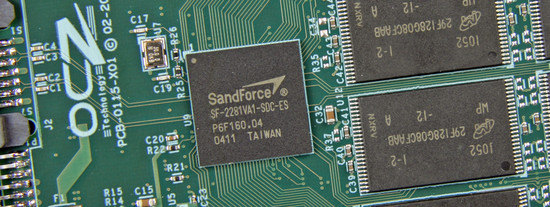SandForce has set the bar for SSDs in 2011 up high with the introduction of its second generation SSD controllers in the SF-2000 family. OCZ Technology has shown how its Vertex 3 SSD brings performance to all new levels thanks to the SF controller, and other companies like Corsair and G.Skill are preparing their own drives.
Corsair and G.Skill will just like OCZ with Vertex 3 use the retail version of SandForce SSD controller, SF-2200. Corsair will build on the popular Force series and will start shipping the Force GT in Q2 2011 sporting the new SandForce controller paired with MLC NAND flash, exactly which we don’t know. The unit is specified to 520 MB/s at sequential read and 500 MB/s at sequential write. This is a bit lower than Vertex 3, but still good news that it uses SandForce’s performance firmware and offers 60,000 IOPS at read and write of 4K random files.

SandForce SF-2200 looks to become a favorite in 2011
G.Skill Phoenix II uses the same SandForce SF-2200 controller and with a SATA 6.0 Gbps interface the fresh unit will appear in the middle of Q2 2011. It did not mention which memory circuits it will use but juding from the first benchmarks it has shared it has chosen to use SandForce’s finest firmware. G.Skill specifies the unit to 550 MB/s read and 500 MB/s write of data.

| SSD | Corsair Force GT | G.Skill Pheonix II | OCZ Vertex 3 | Vertex 2 120 |
| Controller | SF-2200 series | SF-2200 series | SF-2281 | SF-1220 |
| Interface | SATA 6.0 Gbps | SATA 6.0 Gbps | SATA 6.0 Gbps | SATA 3.0 Gbps |
| Capacity | 120/240 GB | 120/240 GB | 120/240 GB | 120 GB |
| Read speed |
520 MB/s | 550 MB/s | 550 MB/s | 285 MB/s |
| Write speed |
500 MB/s | 500 MB/s | 525 MB/s | 275 MB/s |
| 4K write speed |
60,000 IOPS | 60,000 IOPS (unconfirm,) | 60,000 IOPS | 50,000 IOPS |
| MTBF | – | – | 2,000,000 hours | 2,000,000 hours |
Exactly how the new units will stand up to each other will depend on the choice of NAND flash and possible firmware optimizations. OCZ has a theoretic advantage in the specifications, but actual performance and benchmarks may change the picture.















